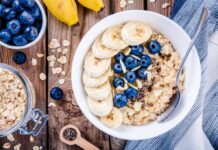
Vitamin D affects multiple body functions, including bone health. Researchers also suggest low vitamin D levels could be a risk factor for auto-immune diseases. You can expose your body to more sunlight to build up your vitamin D.
However, the absorption can vary based on the time of day and your skin type. This is why getting vitamin D from food or supplements is best. This article will cover 7 healthy foods high in vitamin D.
Fatty Fish
Salmon is a popular fatty fish and an excellent source of vitamin D. According to the United States Department of Agriculture (USDA) Food Consumption Database, one 3.5-ounce (100-gram) serving of farmed Atlantic salmon contains 526 IU of vitamin D.
Cod Liver Oil
Cod liver oil is a popular supplement and an excellent source of vitamin D. At approximately 450 IU per teaspoon (4.9mL), it clocks in at a massive 56% of the daily value (DV) for vitamin D, which is 800 IU (20 mcg). Cod liver oil has also been used for years to treat vitamin D deficiency.
Herring and Sardines
Herring is a great source of vitamin D as Fresh Atlantic herring offers 214 IU per 3.5-ounce (100-gram) serving, which is 27% of the DV. Additionally, canned sardines provide 193 IU or 24% of the DV in a 3.5-ounce (100-gram) serving.
Egg Yolks
The yolk from a single large egg contains 37 IU of vitamin D or 5% of the DV. Additionally, eggs from chickens given vitamin D-enriched feed could contain up to 34,815 IU of vitamin D per 100 grams of yolk.
Canned Tuna
Canned light tuna provides up to 269 IU of vitamin D in a 3.5-ounce (100-gram) serving, which is 34% of the DV.
Mushrooms
Like humans, mushrooms can synthesize vitamin D when exposed to UV light. That said, mushrooms produce vitamin D2, while animals produce vitamin D3.
Some wild mushrooms are an excellent source of vitamin D2 due to their exposure to UV light. For instance, one cup of morels contains 136 IU of vitamin, 17% of the DV.
Vitamin D-fortified Foods
Natural forces of vitamin D are limited if you don’t like fish or you’re vegetarian. Luckily, some food products are fortified with this nutrient.
For instance, cow’s milk is fortified with vitamin D in several countries, with one cup containing 115 IU of vitamin D per cup or approximately 15% of the DV. If lactose intolerant, you can try fortified orange juice containing 100 IU of vitamin D (12% of the DV).
Conclusion
Although our bodies can create vitamin D from UV light from the sun, it’s not necessarily the best way to meet your needs. You can get all the vitamin D you need for your body with the foods we have covered.


















